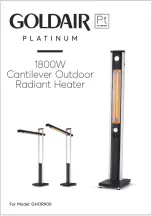
18
www.allmand.com
The truck operator is responsible for securing the load prop-
erly to his trailer.
Lifting The Heater Trailer
WARNING
Attempting to lift the heater trailer with a lifting device that
is underrated or damaged could result in death or serious
injury. Always make sure the lifting device is rated to lift
the weight of the heater trailer. Make sure that the lifting
device is not damaged and is in operable condition before
beginning the lift.
WARNING
Standing or walking under elevated equipment could
result in death or serious injury. When elevating or lifting
the heater trailer, always keep clear of the area around
and under the heater trailer, and do not allow others in the
area.
The heater trailer is equipped with two lifting eyes at the
top of the trailer. See Heater Trailer Weight for the weight of
the heater trailer. Each lifting eye is rated for 3,000 pounds
(1,361 kg). Use both lifting eyes when attempting to lift the
heater trailer. The lifting eyes are intended carry the weight
of the Maxi-Heat heater trailer only, and no additional weight.
The heater trailer is not intended to be suspended for long
periods of time.
The heater trailer is not equipped with forklift pockets. Do not
attempt to lift the heater trailer with a forklift.
Operation
Work Site Considerations
Prior to setting up and operating the heater trailer, the opera-
tor must determine where to place it on the work site. When
placing the heater trailer, consideration must be given to
ground conditions, proximity to combustible or flammable
material and ventilation.
It is the operator’s responsibility to ensure that the heater
trailer is properly and safely positioned on stable surface at
the work site. Be sure to follow rules or instructions for your
work site for locating the heater trailer.
Ground Conditions
The heater trailer must be placed on a firm stable surface
that will support the total weight of the trailer, and support the
force exerted on the ground at the tongue jack. The surface
should be level, but must not exceed a grade of 2.5% (1.4°
incline) in any direction. Grades greater than 2.5% may
cause the heater trailer to roll away. Always chock both sides
of each wheel prior to disconnecting the heater trailer from
the tow vehicle.
Proximity To Combustible Or Flammable
Material
The heater must be kept away from combustible or flam-
mable material. Maintain a distance of at least 8 feet (2.5
m) from the air outlet, and 5 feet (1.5 m) from the top and air
inlet side from any combustible or flammable material.
Carbon Monoxide Asphyxiation
WARNING
Operating the engine or the heater units in a non-ventilated
enclosed area could result in death or serious injury.
Always operate the engine and the heater units in a well
ventilated area.
The engine and the chimneys of the heater units exhaust car-
bon monoxide gas which can cause asphyxiation when the
engine or the heater units are run in an enclosed area. Make
sure that the heater trailer is in a well ventilated area before
starting the engine or operating the heater units.
Carbon monoxide gas is not present at the heater outlet. The
combustion chamber of the heater unit is separate from the
heated air passing over it to the heater outlet. Occasionally,
the odor of diesel fuel may be present with the heated air
at the outlet. This does not indicate the presence of carbon
monoxide gas.
Using The Ground Rod
The heater trailer is equipped with a earth grounding system.
This system consists of a ground rod, a grounding cable and
a ground lug on the outside of the heater trailer. The ground
rod is a safety device that reduces the chance of personal
injury from stray electrical currents. Therefore, Allmand rec-
ommends using the ground rod whenever the heater trailer is
in use. It is the user’s responsibility to determine the require-
ments and / or applicability of national, state or province and
local electrical code, which governs the use of the ground
rod.
To install the ground rod:
1. Open the rear engine cover door and secure with the
door cover holders. The ground rod with grounding cable
is stored on the left side of the trailer to the left of the fuel
tank.
2. Unwind the grounding cable from the ground rod. Leave
the grounding cable securely attached to the ground rod.
3. Find the ground lug at the left rear of the trailer chassis.
See Figure 15. Locate a point on the ground not more
than 5 feet (1.5 m) from the ground lug. Drive the ground
rod into the earth at this point.
4. Remove the wing nut from the ground lug, and attach the
grounding cable to the ground lug. Secure with the wing
nut.
Not
for
Reproduction
















































